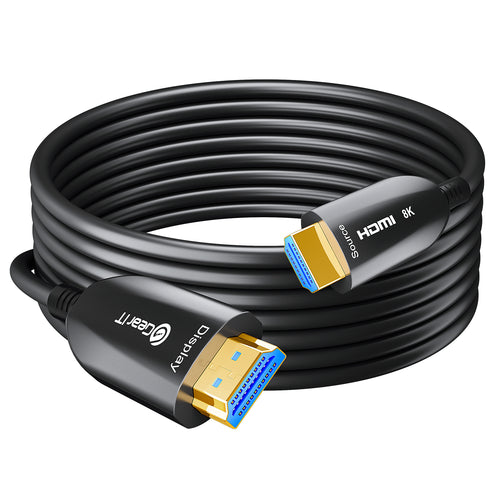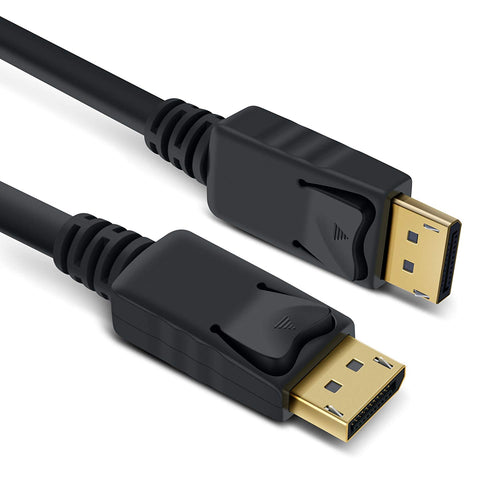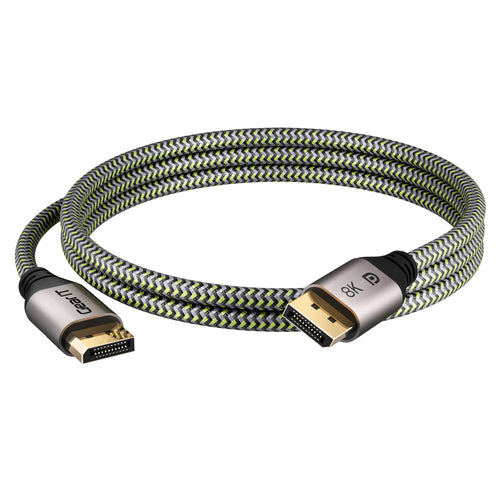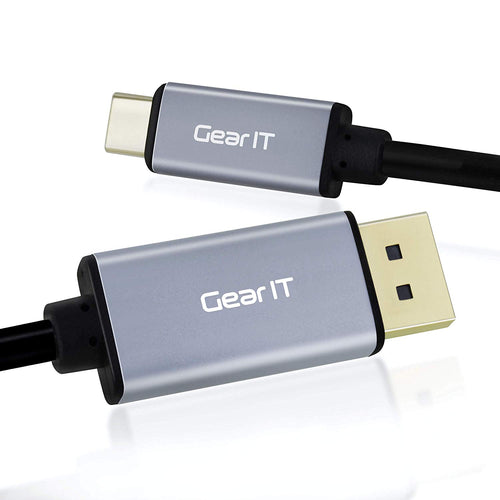Does DisplayPort transmit audio? The answer might surprise you! DisplayPort isn’t just for video, it can also carry audio, making it a strong competitor to HDMI.
But how does it work, and is it the right choice for you? In this article, we’ll explore DisplayPort’s features, compare it to other options, and reveal why it could be the perfect fit for your setup.
Ready to uncover the truth about DisplayPort and audio? Keep reading!
What Is DisplayPort? A Quick Overview
DisplayPort is a digital interface that you use to transmit both audio and video. It's designed to deliver high-quality media output, making it ideal for various modern devices.
The photo above is the: 🛒 8K DisplayPort Cable - DP 1.4 Cable - 8K@60Hz / 4K@144Hz / 2K@165Hz, Braided
Features Include:
-
Developed by VESA: DisplayPort was created by the Video Electronics Standards Association (VESA).
-
Use in Modern Devices: You'll find DisplayPort in PCs, monitors, gaming setups, and more.
Its ability to handle high resolutions like 4K and 8K makes it a preferred choice for those seeking excellent picture quality.
You also benefit from its capability to transmit multi-channel audio, providing a complete media experience through a single cable.
This makes your setup less cluttered while maintaining performance.
Does DisplayPort Transmit Audio? The Definitive Answer
DisplayPort is designed to transmit both video and audio signals smoothly. It integrates audio capabilities similar to HDMI, so there's no need for separate audio cables. This feature makes it a popular choice for connecting devices like computers to monitors and gaming systems.
DisplayPort handles high-definition audio formats effectively. You can enjoy surround sound and multi-channel audio through a single cable. This makes it a versatile option for high-quality audio experiences without the clutter of multiple cables.
Examples of setups using DisplayPort:
-
PC-to-monitor connections: Perfect for seamless video and audio with minimal setup.
-
Gaming systems: Gamers benefit from enhanced audio performance with minimal delays.
-
Laptop docking stations: Ideal for extending displays and audio outputs in office setups.
By supporting these audio and video capabilities, DisplayPort offers a streamlined solution for high-definition media needs. Whether you're at work or play, you can rely on DisplayPort for a clean and efficient multimedia setup.
How to Enable Audio Over DisplayPort
To enable audio over DisplayPort, follow these steps:
-
Connect Your Device: Use a DisplayPort cable to connect your PC or other device to your monitor or TV. Make sure that both the cable and the display you are using support audio transmission.
-
Set Audio Output in Your Operating System:
-
Windows: Right-click the speaker icon in the system tray. Select "Open Sound settings." Choose your monitor from the list under "Output devices."
-
macOS: Open "System Preferences." Click "Sound" and select your display as the output device.
-
Configure Your Monitor or TV: Make sure your monitor or TV is set to receive audio from the DisplayPort input. This option might be available in the audio or input settings of your device's menu.
Examples of Settings:
|
Operating System |
Instructions |
|
Windows |
Open Sound settings from the taskbar, select your monitor. |
|
macOS |
Go to System Preferences > Sound, then choose your monitor. |
Using screenshots as visual aids in your operating system settings can help ensure you've selected the right audio output device.
📌 Remember, if audio doesn't work, test with another cable or check if your monitor settings need updating.
Why Choose DisplayPort for Audio and Video Transmission?
✅ High Bandwidth: DisplayPort offers high bandwidth, allowing for uncompressed audio and video transmission. This makes it a great choice for high-resolution displays and detailed audio. Video signals up to 8K resolution can be supported, making your viewing experience impressive.
✅ Multi-Monitor Support: If you need to connect multiple displays, DisplayPort is ideal. It supports daisy-chaining, which lets you run several monitors from a single port. This feature is popular with professional setups and gaming enthusiasts wanting expanded screen space.
✅ Audio Quality: Audiophiles will appreciate DisplayPort's compatibility with high-definition audio formats. You can enjoy rich sound using formats like DTS-HD and Dolby Atmos. This enhances not only video but also the audio experience, making it more immersive.
✅ Comparison with HDMI: While HDMI is widely used, DisplayPort often delivers better performance in professional and gaming environments. It supports higher refresh rates and better resolutions. HDMI is more common in consumer electronics, but DisplayPort excels in specific high-performance settings.
Quick Comparison
|
Feature |
DisplayPort |
HDMI |
|
Resolution |
Up to 8K |
Up to 10K |
|
Multi-Monitor |
Supports daisy-chaining |
Limited without additional equipment |
|
Audio Formats |
High-definition like DTS-HD, Dolby Atmos |
Similar support |
When choosing DisplayPort, consider your need for high resolution, multi-monitor setups, and high-quality audio experiences. DisplayPort's capabilities make it a strong option for advanced audio and video transmission needs.
Common Issues with Audio Over DisplayPort and How to Fix Them
When using DisplayPort for audio, you might run into some issues. Here are the most common problems and simple ways to fix them:
-
No Audio Output
-
Check if the DisplayPort cable is securely connected at both ends.
-
Loose connections can stop audio from working.
-
Compatibility Issues
-
Older monitors or adapters might not support audio over DisplayPort.
-
Verify if your monitor or adapter is designed for audio transmission.
-
Intermittent Audio Drops
-
A faulty cable or outdated drivers can cause audio to cut out.
-
Update your GPU and audio drivers to the latest versions.
-
Incorrect Audio Settings
-
Make sure your system is using the correct audio output.
-
Right-click the speaker icon on your taskbar, go to sound settings, and select your monitor as the audio device.
-
Faulty Hardware
-
Test with another cable or device to see if the problem is hardware-related.
-
If audio works with a different setup, replace the original cable.
-
Adapter Limitations
-
Some adapters, like DisplayPort to HDMI, might not support audio.
-
Check the adapter’s specifications to confirm audio compatibility.
These tips should help you fix most audio issues with DisplayPort!
Does DisplayPort Transmit Audio Better Than HDMI?
When comparing audio capabilities, both DisplayPort and HDMI offer high-quality, multi-channel audio, making them both reliable choices.
HDMI: It includes features like ARC (Audio Return Channel) and eARC, which are particularly useful for home theater setups. These features allow you to send audio from your TV back to a sound system without needing additional cables.
DisplayPort: While it doesn’t provide ARC or eARC, it is favored in professional settings. You often see it in multi-monitor setups where audio may not be the primary concern.
Key Features:
-
Audio Quality: Both support up to 8 channels of uncompressed audio.
-
Usage: HDMI is often in home entertainment systems, while DisplayPort thrives in professional environments.
In choosing between them, consider your needs. If your goal is to set up a home theater, HDMI might offer more flexibility with its ARC/eARC capabilities. However, if you are looking into multi-display computer setups, DisplayPort is more common.
📌 Both DisplayPort and HDMI are excellent for transmitting audio, but your decision should focus on what fits your specific use.
How to Choose the Right DisplayPort Cable for Audio Transmission
The photo above is the: 🛒 4K DisplayPort Cable - 4K@60Hz / QHD 1440p@144Hz / FHD 1080p@144Hz
When picking a DisplayPort cable, follow these tips to avoid issues and ensure good audio quality:
Choose a Certified Cable
-
Certified cables ensure smooth transmission of both audio and video signals.
-
Look for cables labeled for audio support to avoid compatibility problems.
Pick the Right DisplayPort Version
-
DisplayPort 1.2: Handles basic audio and video needs.
-
DisplayPort 1.4: Offers higher bandwidth for better audio and video quality.
-
DisplayPort 2.0: Supports the latest advanced audio and video features.
Go for High-Quality Cables
-
Low-quality cables can cause poor audio or signal dropouts.
-
Choose well-made cables from trusted brands to ensure a stable connection.
Be Cautious with Longer Cables
-
Longer cables can cause signal loss, which may affect audio quality.
-
Use the shortest cable possible to maintain a strong signal.
Quick Summary
Check for certification, select the right DisplayPort version for your device, and prioritize high-quality materials to ensure clear and reliable audio transmission.
Conclusion: Does DisplayPort Transmit Audio? Yes, and Here's Why It Matters
DisplayPort does transmit audio along with video, making it a great choice for gaming, work, and entertainment. It supports high-quality audio formats, ensuring a smooth and immersive experience. For the best results, use a certified DisplayPort cable to enjoy superior audio and video. Upgrade your setup today!
Looking for high-quality cables to upgrade your setup? GearIT offers top-notch DisplayPort and HDMI 2.0 cables that ensure seamless audio and video performance. Whether you're gaming, streaming, or working, GearIT cables deliver the reliability and clarity you need.
👉 Shop GearIT DisplayPort Cables and HDMI 2.0 Cables today to experience the best in connectivity!
Frequently Asked Questions
DisplayPort is a versatile interface that not only supports high-definition video but also transmits audio. It can handle surround sound and provide an alternative to HDMI.
Can DisplayPort transmit audio to TVs?
Yes, DisplayPort can transmit audio to TVs. When connected with a compatible cable, it sends both high-definition video and audio, making it a great choice for home entertainment systems.
Why is my DisplayPort audio not working?
If your DisplayPort audio is not working, check your device settings to ensure the correct audio output is selected. Also, ensure your cable is properly connected and not damaged.
Does DisplayPort support surround sound?
DisplayPort supports surround sound, providing a rich audio experience for movies and games. This capability makes it comparable to HDMI for many users seeking high-quality sound.
Is DisplayPort better than HDMI for audio?
Both DisplayPort and HDMI transmit high-quality audio, but HDMI is more commonly used in home theater setups. DisplayPort can be a great option, especially for computer monitors or setups requiring high display resolutions.
Can I use DisplayPort for audio-only transmission?
While DisplayPort primarily transmits video and audio together, it can be configured for audio-only transmission if your setup permits. You may need to adjust settings on your source device to allow this.
Does DisplayPort send sound?
Yes, DisplayPort does send sound. It carries digital audio along with video through the same cable, using a packet-based transmission method similar to how it handles video data, making it efficient.























































